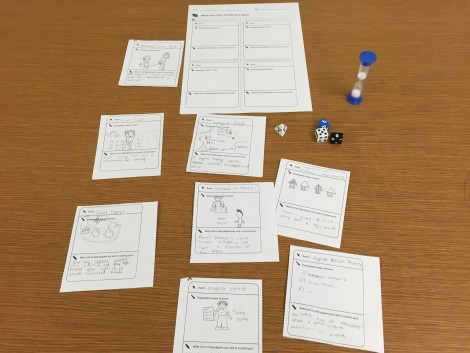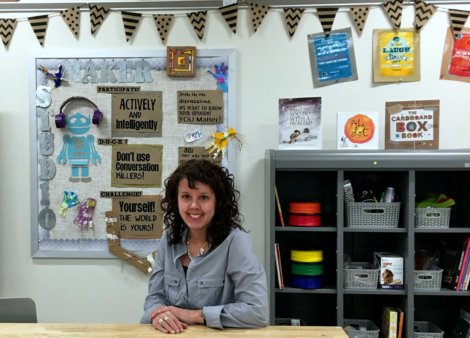
Systems Thinking with BrainPOP
Posted by cemignano on
Earlier this month, we introduced you to June’s Certified BrainPOP Educator of the month, Matthew Farber. Next up is Matt’s reflection of the 2015-2016 school year and how he shaped his teaching around the concept of systems thinking. Read to on to take a peek into his classroom and how he integrated the use of BrainPOP throughout his lessons.
I framed this entire past school year around the concept of systems thinking. A 21st century skill, it is a way of viewing the world as a series of interconnections. Rather than the linear view of cause and effect, systems thinking is cyclical, modeled as a series of causal loops. Systems thinkers look at how components interrelate, as well as how those relationships fit within other systems. The real world is comprised of these complex and dynamic systems. For example, after America had its revolution, then France followed.
In my middle school social studies class we use BrainPOP’s Make-a-Map tool to connect parts of a whole. I may propose a problem, like, “What does the Silk Road have to do with the Black Death?” After reviewing BrainPOP videos and related content, students soon realize that the plague spread along the interconnected routes that connected Europe to Asia ideas. A series of seemingly unrelated topics becomes visible using BrainPOP’s robust toolsets. Concept mapping is effective to teach systems thinking in other content areas too. Ask students to map how blood cells interact with pathogens, or how characters set events in motion in novels.
Games are particularly effective at teaching systems thinking. After all, a game is a complex system, made up of choices that have consequences. I begin each school year by showing students the BrainPOP video on Game Theory. Yes, a math video in social studies class! Game theory, made famous by people like John Forbes Nash (played by Russell Crowe in the film adaptation of A Beautiful Mind) is about how rational people make decisions when playing a game. This model became of value to the United States during the Cold War nuclear face-off. Of note is the Prisoner’s Dilemma, which is included in BrainPOP’s resources connected to the Game Theory video. The Prisoner’s Dilemma pertains to two suspects in two different police interrogation rooms who have incentives to confess—or to not. My students use game theory to explain why events took place. In a math class students can map out decision trees to see probabilities of outcomes.
Once students understand game theory and concept mapping, the reasons of why we play and design games in social studies class become evident. Aside from being fun and engaging—as well as educational—playing games drives home the concept of systems thinking. Games model real world systems. For example, playing Quandary on BrainPOP, my students can immediately see the effects of their decisions, via the game’s feedback system. After play I have the class write about the Jamestown colony, comparing it to the settlers of Braxos, the fictional planet settled in Quandary. Students also learning about the effects of the Bill of Rights by playing Do I Have a Right? on BrainPOP’s GameUp page.
In 2014 BrainPOP visited my classroom to test its new timeline game with my students. One of the classes played a paper version, and the other played a digital prototype. Released last fall as Time Zone X, the game is about causes and effects throughout history. It challenges players to contextualize what was happening in time when something occurred. In my class I have students play it prior to the start of a new unit. They playfully learn about history through trial-and-error. It is a true playful assessment!
Going one step further, I have students design their own Time Zone X games. It became the capstone project of the year—students demonstrated mastery of class content, and systems thinking, through the lens of game design. First I printed copies of blank Time Zone X cards from the Educator resource page. Next students were grouped in teams of four, each assigned different sections of a textbook. They then made a deck of 16 cards, to be played by another group as a multiplayer game. Here the digital game of Time Zone X became a model for students to replicate and hack, or mod.
Each group was afforded freedom to change how their Time Zone X remixed games were played. Some incorporated level design: one deck of cards had dates spread out by many years, which was easier to play. Later levels were closer in date (e.g., Britain’s series of tax acts against the 13 Colonies took place within a short time frame). Others decided to play their cards differently, like the party game HedBanz. In that game players affix a card to their head and then ask questions about what card they have. It became reverse charades mashed up with 20 questions! And yet others made their games to be the ones they liked to play: Pokémon and Magic: The Gathering. In the end all playfully assessed each other on the year’s course content.
Using BrainPOP’s resources enabled by students to analyze the real world with concept maps. What’s more they understand why historical figures made the decisions they did. After all, in this age of Siri and Google, anyone can get access to facts at anytime. It is far more important to teach children to be critical thinkers. Making games gave my students agency over their learning. As they move on to the next grade level this June, I am confident that they now see the world as an interconnected system, rather just a rote list of facts and dates. For more on systems thinking, games, and education, check out the Institute of Play’s Q Design Systems Thinking Pack.














